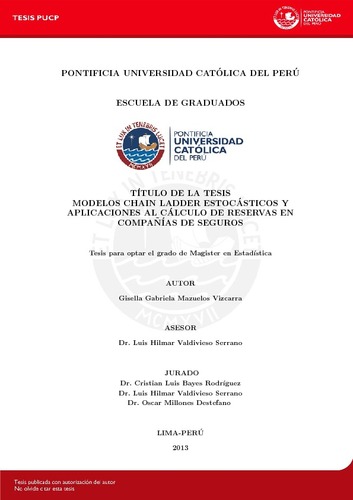| dc.contributor.advisor | Valdivieso Serrano, Luis Hilmar | |
| dc.contributor.author | Mazuelos Vizcarra, Gisella Gabriela | es_ES |
| dc.date.accessioned | 2015-07-20T21:56:48Z | es_ES |
| dc.date.available | 2015-07-20T21:56:48Z | es_ES |
| dc.date.created | 2013 | es_ES |
| dc.date.issued | 2015-07-20 | es_ES |
| dc.identifier.uri | http://hdl.handle.net/20.500.12404/6176 | |
| dc.description.abstract | This document is intented to deepen the study of univariate and multivariate Chain Ladder
methods for estimating reserves in an insurance company. It presents from a theoretical
and applicative perspective both the univariate deterministic and stochastic Chain Ladder
methods. Although, the first is the most used method by insurance companies due to its simplicity
and lack of probabilistic assumptions, the second, proposed by Mack (1993), allows
the construction of confidence intervals for the estimated reserves, which is invaluable for
researchers.
We also develop the General Multivariate Chain Ladder model, which has the basic
premise to analyze the possible relationship that may exist between different development
triangles, thus providing another tool to improve inferences and predictions of reserves.
These methods have been developed and applied to a database of 3 types of health insurance,
thus showing the advantages and disadvantages of each of them in different scenarios
and providing various tools for decision making in meeting the future obligations of insurance
companies. | en_EN |
| dc.description.abstract | El presente documento tiene por objetivo profundizar en el estudio de los m´etodos univariados
y multivariados del modelo Chain Ladder para la estimaci´on de las reservas de una
compa˜n´ıa de seguros. Se presenta de manera te´orica y aplicativa tanto los m´etodos univariados
Chain Ladder determin´ıstico como Chain Ladder estoc´astico. Si bien el primero de
estos m´etodos es el m´as utilizado por las compa˜n´ıas de seguro dada su simplicidad de c´alculo
y carencia de supuestos probabil´ısticos, el segundo, propuesto por Mack (1993), permite la
construcci´on de intervalos de confianza para las reservas, lo cu´al es de invalorable ayuda para
los investigadores.
Asimismo, desarrollamos el modelo General Multivariado Chain Ladder, el cual tiene
como premisa b´asica analizar la posible relaci´on que pueda existir entre diversos tri´angulos
de desarrollo, dotando as´ı de otra herramienta para mejorar las inferencias y predicciones de
las reservas.
Estos m´etodos han sido desarrollados y aplicados sobre la base de datos de 3 tipos de
seguros de salud, mostrando as´ı las ventajas y desventajas de cada uno de ellos en diferentes
escenarios y proporcionando distintos instrumentos para la toma de decisiones relacionados
en el cumplimiento de las obligaciones futuras de las compa˜nias de seguros. | es_ES |
| dc.language.iso | spa | es_ES |
| dc.publisher | Pontificia Universidad Católica del Perú | es_ES |
| dc.rights | info:eu-repo/semantics/openAccess | es_ES |
| dc.rights.uri | http://creativecommons.org/licenses/by-nc-nd/2.5/pe/ | * |
| dc.subject | Modelos estocásticos | es_ES |
| dc.subject | Estimación | es_ES |
| dc.subject | Análisis estocástico | es_ES |
| dc.subject | Análisis multivariante | es_ES |
| dc.subject | Análisis de regresión | es_ES |
| dc.subject | Compañías de seguros | es_ES |
| dc.title | Modelos Chain Ladder estocásticos y aplicaciones al cálculo de reservas en compañías de seguros | es_ES |
| dc.type | info:eu-repo/semantics/masterThesis | es_ES |
| thesis.degree.name | Maestro en Estadística | es_ES |
| thesis.degree.level | Maestría | es_ES |
| thesis.degree.grantor | Pontificia Universidad Católica del Perú. Escuela de Posgrado | es_ES |
| thesis.degree.discipline | Estadística | es_ES |
| renati.advisor.dni | 07958730 | |
| renati.discipline | 542037 | es_ES |
| renati.level | https://purl.org/pe-repo/renati/level#maestro | es_ES |
| renati.type | http://purl.org/pe-repo/renati/type#tesis | es_ES |
| dc.publisher.country | PE | es_ES |
| dc.subject.ocde | https://purl.org/pe-repo/ocde/ford#1.01.03 | es_ES |






